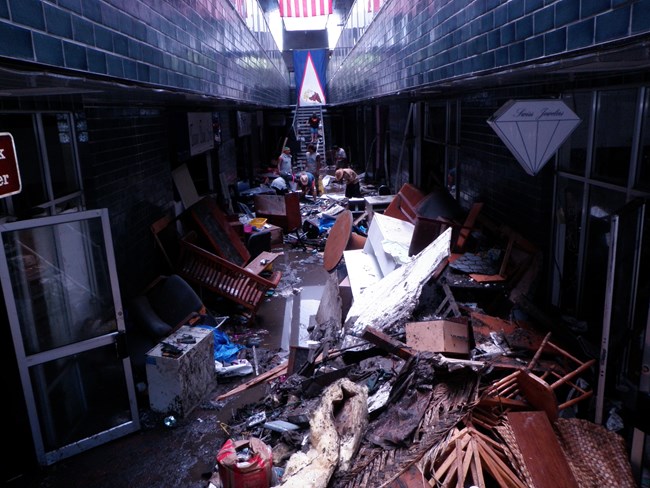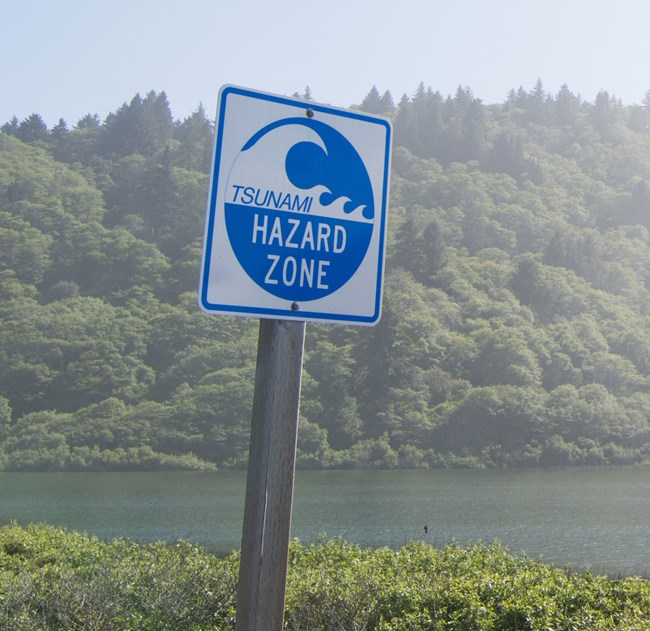Part of a series of articles titled Coastal Geohazards.
Previous: Coastal Geohazards—Storm Surges
Article

NPS Photo.
A tsunami is a series of water waves generated by any large displacement of the sea surface. Seafloor uplift from an earthquake is the most common cause of a tsunami, but volcanic eruptions, underwater landslides, or meteorite impacts can also generate tsunami waves. In the open ocean these waves may only be a few inches high, but can travel at speeds in excess of 500 mph (805 km/h)! In contrast, when tsunami waves reach shallow water, they slow down considerably and may reach heights up to tens of meters. Upon making contact with the shore, tsunamis can severely alter the coastal landscape through rapid erosion and deposition of sediment. High wave energy may transport coastal vegetation and marine debris and leave in place unstable barren dunes susceptible to further erosion. Tsunami events have impacted and led to the closure of coastal parks.
A tsunami generated by a magnitude 9.0 earthquake off the coast of Japan struck Pu‘uhonua O Hōnaunau and Kaloko-Honokōhau National Historical Parks on March 11, 2011. At Pu‘uhonua O Hōnaunau, repeated tsunami surges overtopped walls and travelled hundreds of feet inland. Several sites and features sustained damage, including collapsed, breached, and bulging walls, eroding cultural deposits, and washed out sections of trail. About 80% of the sand and fill material present in the Royal Grounds area of the park was either removed or displaced by the tsunami surges. Damaging events like this challenge the long term survival of historically significant coastal areas.
In 2009 the 8.1 Samoa earthquake generated tsunami waves that reached up to 40 ft (12 m) in height and flooded areas more than a third of a mile (600 m) inland. The tsunami caused widespread damage and destroyed the National Park of American Samoa headquarters and visitor center. The buildings were located in Pago Plaza at the very head of Pago Pago Harbor. The narrowing of the harbor at this point funnels water and makes it particularly vulnerable to tsunami damage. A total of five waves swept the area causing damage to newly installed exhibits, park maintenance equipment, and cultural resources storage. Villages on every side of the island were affected and multiple homes were destroyed.

NPS Photo by Henry Crawford.
Crescent City, California, home to the Redwood National and State Park Information Center, experienced a significant tsunami following the 1964 Anchorage, Alaska earthquake. In only four hours, 950 megatons of energy was transferred from earth to water and formed a tsunami that surged 21ft (6.1m) in Crescent City. Today, the park is actively raising tsunami awareness; it was the first unit of the National Park service to earn Tsunami Ready certification by the National Weather Service.
Tsunamis may eventually visit every coast in the Pacific Ocean due to high seismic activity. Although less common, the Atlantic Ocean and Great Lake coasts may still be at risk through causal factors such as landslides or meteorite impacts. It is always best to be prepared. Here are some facts and safety tips about tsunamis you should know:
Part of a series of articles titled Coastal Geohazards.
Previous: Coastal Geohazards—Storm Surges
Last updated: December 12, 2018